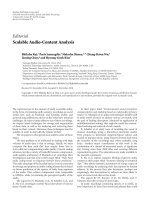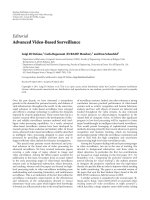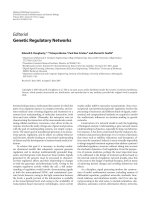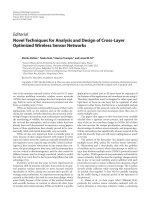Báo cáo hóa học: "Editorial Scalable Audio-Content Analysisg" pptx
Bạn đang xem bản rút gọn của tài liệu. Xem và tải ngay bản đầy đủ của tài liệu tại đây (420.46 KB, 2 trang )
Hindawi Publishing Corporation
EURASIP Journal on Audio, Speech, and Music Processing
Volume 2010, Article ID 467278, 2 pages
doi:10.1155/2010/467278
Editorial
Scalable Audio-Content Analysis
Bhiksha Raj,
1
Paris Smaragdis,
2
Malcolm Slaney,
3, 4
Chung-Hsien Wu,
5
Liming Chen,
6
and Hyoung-Gook Kim
7
1
Carnegie Mellon University, PA 15213, USA
2
Advanced Technology Laboratories, Adobe Systems Inc., Newton, MA 02466, USA
3
Yahoo! Research, Santa Clara, CA 95054, USA
4
Center for Computer Research in Music and Acoustics (CCRMA), Stanford University, CA 94305-8180, USA
5
Department of Computer Science and Information Engineering, National Cheng Kung University, Tainan, Taiwan
6
Department of Mathematics and Informatics, Ecole Centrale de Lyon, University of Lyon, 69006 Lyon, France
7
Intelligent Multimedia Signal Processing Laboratory, Kwangwoon University, Seoul 139-701, Republic of Korea
Correspondence should be addressed to Bhiksha Raj,
Received 31 December 2010; Accepted 31 December 2010
Copyright © 2010 Bhiksha Raj et al. This is an open access article distributed under the Creative Commons Attribution License,
which permits unrestricted use, distribution, and reproduction in any medium, provided the original work is properly cited.
The rapid increase in the amount of easily accessible audio,
in the for m of streaming audio content, recordings on social
media sites such as Facebook and Youtube, public and
personal song collections, and so on has raised new technical
challenges. In order to make effective use of these recordings,
we require smart techniques for storage and organization
of these data, as well as for analyzing and retrieving them
based on their content. Moreover, these techniques must be
scalable, in order to deal with the volume of data.
The six papers in this special issue address some of these
topics.
The first problem to be addressed in dealing with large
volumes of audio data is that of storage. Ideally, we must
compress the data such that they require fewer bits to
store while not compromising audio quality. Current coding
schemes provide a variety of tradeoffs between compression,
audio quality, and latency. P. Motlicek et al. contribute their
investigations into this a rea in their paper titled “Wide-band
audio coding based on frequency-domain linear prediction.”
They take advantage of the fact that latency is not a constraint
for storage and propose an audio coding scheme that is based
on linear prediction of the spectra of fairly long segments
of the audio. They achieve compression rates comparable
to MPEG4, while yet retaining the perceptual quality of the
audio.
The papers by N. Misdariis et al., B. Schuller et al., and
X. Ma et al. investigate content-based description of various
types of audio data.
In their paper titled “Environmental sound perception:
metadesc ription and modeling based on independent primary
studies” N. Misdariis et al. apply methodologies usually u sed
to study timbre of music to analyze various car sounds, with
the goal of finding descriptors (obtained by application of
multidimensional scaling) that might be useful for content-
based indexing and retrieval of such sounds.
B. Schuller et al. study ways of modeling the mood of
musical recordings using a discretized emotional model.
They propose to determine nonprototypical valence and
arousal in popular music, using features derived both from
the acoustics of the recordings and, where available, song
lyrics. Another major contribution of this work is the
constitution of a dataset of annotated music of significant
size, having more than 2000 titles and covering different
representative genres. The annotations are made available to
the research community.
X. Ma et al. explore semantic labeling of generic audio
content in their paper titled “Semantic labeling of nonspeech
clips.” They obtain semantic annotations of a large corpus of
audio recordings by analyzing their descriptions by human
subjects. In the process they also determine, perhaps not
surprisingly, that descriptions by subjects a re more likely to
agree at coarse levels than at fine levels.
The papers by M. Rouvier et al., M. Hel
´
en, and T.
Virtanen deal with retrieval of stored data.
In audio recordings containing speech, it is useful, or
even important, to detect key words and phrases that could
2 EURASIP Journal on Audio, Speech, and Music Processing
be used to index or retrieve the recordings or tag them
for further analysis. In large and continuously expanding
corpora,thismustbedonefast,yeteffectively. In their paper
titled “Query-driven strateg y for on-the-fly term spotting in
spontaneous speech,” Rouvier et al. propose a fast two-level
architecture for detecting key words in spontaneous speech
recordings. The first level performs a fast detection of speech
segments that are likely to contain the desired terms. The
second level refines the detection further using a speech
recognizer and a query-driven decoding algorithm.
In their paper, titled “Audio query by example using
similarity measures between probability density functions of
features,” M . Hel
´
en and T. Virtanen address an alternate
problem: retrieval of generic (i.e., not necessarily speech-
containing) audio. In particular, they consider the problem
of query by example—retrieving other instances of audio that
are similar to a given example. They investigate a number of
different approaches and find that similarity measures based
on distances between probability dist ribution functions
computed from audio recordings result in the best retrieval.
No single issue of any journal can reasonably expect to
cover even a small fraction of the problem s pace we address,
and we do not strive to do so in this issue. Rather, it is
our hope to provide a selection of good-quality papers that
touch upon various aspects of the problem, that are both
informative and enjoyable to read, and that present novel
approaches or provide new insights that might be of use to
the research community. We believe that the selection we
have provided reflects these goals, and we hope you agree.
Bhiksha Raj
Paris Smaragdis
Malcolm Slaney
Chung-Hsien Wu
Liming Chen
Hyoung-Gook Kim









